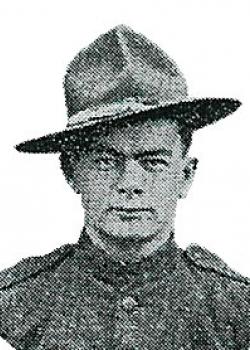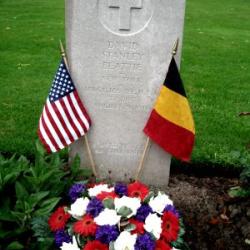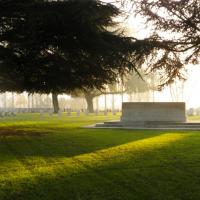BEATTIE DAVID STANLEY
BEATTIE DAVID STANLEY
Unité et Div
Née
Entered Service From
Décédés
English:
Sergeant D. Stanley Beattie was born in 1896, the son of David and Isabel Beattie of Troy, New York. He joined the 2nd Infantry Regiment of the New York Army National Guard. This regiment was mustered into federal service on 1 July 1916 for action against Pancho Villa on the Mexican border. Although the regiment suffered no casualties, it was not easy duty. At one point, the regiment endured a 125-mile, ten-day march through typhoid-infected territory in temperatures over 100 degrees. After the situation in Mexico quieted down, the New York National Guard was released from federal duty on 18 October 1916. The regiment would not be at rest for long. Six months later, on 25 March 1917, the regiment was again called into federal service in preparation for the First World War.
At first, the regiment guarded railroad bridges and munitions factories in New York against sabotage. However, in early 1918 it was assigned to the 27the Division and re-designated the 105th Infantry Regiment. It shipped to Europe in May and arrived in France on Memorial Day 1918. It was assigned to the British Third Army for training. On 14 July, it became the first American regiment to take over a sector of the trench lines in Belgium, occupying a section of the Dikkebus Line near Poperinge.
Sgt. Beattie was a forward artillery observer for his regiment, and he was killed at his post by artillery shrapnel on 31 August 1918. An obituary in the Troy Times of Friday 27 September 1918 said this about him:
"Sergeant Beattie was one of the most popular young soldiers in the local regiment. He was the son of Mr. and Mrs. David L. Beattie, of 22 Hawthorn Avenue, and was born in this city about twenty-two years ago. He was a graduate of the public schools and the Troy High School and was one of the most popular students in the latter institution. He was manager of the school football team and also a player on the team and was the school correspondent for The Troy Times. He was a member of the debating society and was considered an excellent speaker.
Sergeant Beattie was employed in the Manufacturers Bank before enlisting in his countrys service. He joined Company A of the old Second Regiment and served on the Mexican border. There he was admired for his pluck and fortitude shown on long hikes and in the other work. He remained in the company at the close of the Mexican trouble and when the United States entered the present war went with his company to Camp Wadsworth at Spartanburg. Later he was transferred to the Intelligence Department and promoted to Sergeant. According to a letter received in this city, Sergeant Beattie was at an advanced lookout post, about five miles behind front lines. While on duty there a German shell landed nearby and a fragment of it struck Beattie on the head, just at the temple. He was taken on a stretcher to the rear but died on the way.
Sgt. Myron Fales was an eyewitness to Sgt. Beatties death. In his report to company headquarters, Fales wrote:
"Sgt. David Beattie met his death while on duty in a forward observation post in the Dickebush Sector in Belgium on August 31st 1918. I had just called his attention to a party of Huns moving forward on a path near our field of vision, and had handed over the telescope to him, when a high explosive shell burst directly in front of our post. A fragment of the shell cut through the top of the high parapet of the post and struck Sgt. Beattie over the left temple. He died less than an hour later in the First Aid Station, never regaining consciousness.
Sgt. Beattie was buried at the Lijssenthoek Commonwealth War Graves Cemetery and his family requested that his remains not be disturbed. His family had the following inscription carved into his tombstone: "He Lived By Faith, He Still Lives.
__________________________________________________________
Jerome Sheridan wrote the story above, drawing on the following sources:
- The IDPF of Staff Sergeant Stanley Beattie
- Information provided by Mr. Chris Sims of the Flanders Field American Cemetery and that is now included in the book De Soldaten van de Amerikaanse Militaire Begraafplaats Flanders Field by Patrick Lernout and Christopher Sims (Groeninghe Kortrijk, 2011.)
- Various histories of the First World War
Version Français:
D. Stanley Beattie, fils de David et Isabel Beattie, est né en 1896 dans la ville de Troy, état de New York. Il s'engage dans le 2ème Régiment d'Infanterie de la Garde Nationale de New York. Ce régiment, établi le 1er juillet 1916, a pour but de combattre Pancho Villa sur la frontière mexicaine. Le régiment n'a subi aucune perte humaine, mais la mission a été très pénible: ils ont marché durant dix jours (125 miles soit 201km) à travers des territoires infectés par la typhoïde et dans des températures extrêmes (100 °F, soit 37C°). Le 18 octobre 1916, une fois la situation au Mexique calmée, la Garde Nationale retourne à New York. Le régiment ne sera pas au repos pour longtemps. Six mois plus tard, le 25 mars 1917, il est à nouveau remis en service en vue de la première guerre mondiale.
Dans un premier temps, à New York, il a pour mission de surveiller les ponts, les usines de munitions et les voies de chemin de fer afin d'éviter les sabotages. Cependant, au début de 1918, il est rattaché à la 27ème Division et devient le 105ème Régiment d'Infanterie. Expédié en Europe, le Régiment débarque en France à la fin du mois de mai 1918, le jour du Mémorial. Il est alors rattaché à la 3èmeArmée Britannique pour une période de formation. Le 14 juillet, il est le premier régiment américain à s'emparer d'un secteur de tranchées en Belgique, occupant une partie de la ligne de Dikkebus près de Poperinge.
Le 31 août 1918, au poste d'observateur d'avant garde dans l'artillerie, le sergent Beattie est tué par des éclats d'obus d'artillerie. Le 27 septembre 1918, une notice nécrologique parait dans l'éditorial «Times» de la ville de Troy:
"Le Sergent Beattie a été un des plus populaires jeunes soldats du régiment local. Né dans cette ville il y a environ vingt-deux ans, Il était le fils de M. et Mme David L. Beattie, domiciliés au 22 Avenue de l'Aubépine à Troy. Diplômé de l'école secondaire de Troy où il était très populaire: entraineur et joueur de l'équipe de football, correspondant de presse de l'école pour le Times de Troy, il était aussi considéré comme un excellent orateur. Avant de s'enrôler dans l'armée, le Sergent Beattie était employé à la banque locale. Attaché à la Compagnie A du 2ème Régiment d'Infanterie, il part à la frontière mexicaine où il y démontre beaucoup de courage au cours de diverses missions. Une fois les troubles à la frontière mexicaine contrôlés, sa Compagnie revient à New York et lorsque les États-Unis entrent en guerre, il rejoint le Camp Wadsworth à Spartanburg. Plus tard, il est transféré dans le service de renseignements et promu au grade de Sergent. Le Sergent Beattie se trouvait à un poste d'observation avancé, environ cinq milles derrière les lignes de front lorsqu'un fragment d'obus allemand lui heurta la tête, juste à la tempe. Pris en charge par les ambulanciers et conduit vers les lignes arrières, il meurt en route.»
Le sergent Myron Fales, témoin oculaire de la mort du sergent Beattie, écrit dans son rapport:
« Dans le secteur de Dickebus (Belgique), le 31 août 1918, en position d'avant garde, je viens d'attirer l'attention du Sergent Beattie sur les mouvements d'un groupe de «Huns» sur un sentier devant notre position, je lui tends le télescope, lorsqu'un obus éclate directement devant notre poste. Un fragment de l'obus a heurté le sergent Beattie à la tempe gauche. Il est mort moins d'une heure plus tard, sans jamais reprendre conscience."
Le sergent Beattie est enterré au cimetière de Lijssenthoek (cimetière du Commonwealth War Graves). Après la guerre, selon la volonté de sa famille, sa dépouille n'est pas dérangée mais sa famille fait graver l'inscription suivante sur la pierre tombale: « Il vécut par la foi, il vit. »
Auteur: Jérôme Sheridan
Sources:
- IDPF (information personnelle des archives militaires) du Sergent-chef Stanley Beattie
- Les soldats du Cimetière américain de Flanders Field (Courtrai Groeninghe, 2011.) par Patrick Lernout et Christopher Sims (ce dernier est le guide du Cimetière américain de Flanders Field, Waregem)
- Diverses histoires de la première guerre mondiale
Nederlandse versie:
Sergeant D. Stanley Beattie werd geboren in 1896, als zoon van David en Isabel Beattie, in het stadje Troy, New York. Hij nam dienst in het 2de Infanterieregiment van de New York Army National Guard. Dit regiment werd toegevoegd aan de Federale dienst op 1 juli 1916 om de strijd aan te gaan met Pancho Villa aan de Mexicaanse grens. Het regiment leed wel geen verliezen maar het was zeker geen makkelijke klus. Op een gegeven moment ondernam het regiment een tiendaagse mars van 125 mijl doorheen door tyfus geteisterd gebied, in temperaturen van meer dan 37° Celsius. Op 18 oktober 1919, nadat de situatie in Mexico rustiger werd, werd de New York National Guard ontheven van Federale dienst. Het regiment zou echter niet lang kunnen rusten. Zes maanden later, op 25 maart 1917, werd het regiment opnieuw opgeroepen voor Federale dienst ter voorbereiding van de Groote Oorlog.
In eerste instantie bewaakte het regiment de spoorwegbruggen en munitiefabrieken in New York tegen sabotage. Begin 1918 werd het echter toegevoegd aan de 27ste Divisie en heringedeeld bij het 105de Infanterieregiment. Het regiment vertrok in mei richting Europa en kwam aan in Frankrijk op Memorial Day 1918. Het werd aan het Derde Britse Leger toebedeeld voor training. Op 14 juli werden zij het eerste Amerikaanse regiment om een sector over te nemen van de in België gelegen loopgraven, dit in een stuk van de Dikkebus linie nabij Poperinge.
Sgt. Beattie was een vooruitgeschoven artilleriewaarnemer voor zijn regiment, en sneuvelde op zijn post door Artillerievuur op 31 augustus 1918. Een overlijdensbericht op 27 september 1918 in de Troy Times zei het volgende over hem:
Sgt. Myron Fales was ooggetuige van Sgt. Beattie’s dood. In zijn rapport voor het Compagnie hoofdkwartier schreef hij:
Sgt. Beattie werd begraven op de Lijssenthoek Commonwealth War Graves begraafplaats en zijn familie vroeg om zijn stoffelijk overschot hier te laten rusten. Zijn familie heeft volgend opschrift laten graveren op zijn grafsteen: “Hij leefde volgens zijn geloof, hij leeft verder”.
Voir tout
Voir moins
Vidéos (1)
Filmed in 2009, this video provides a taste of what the isolated grave ceremonies are all about.



